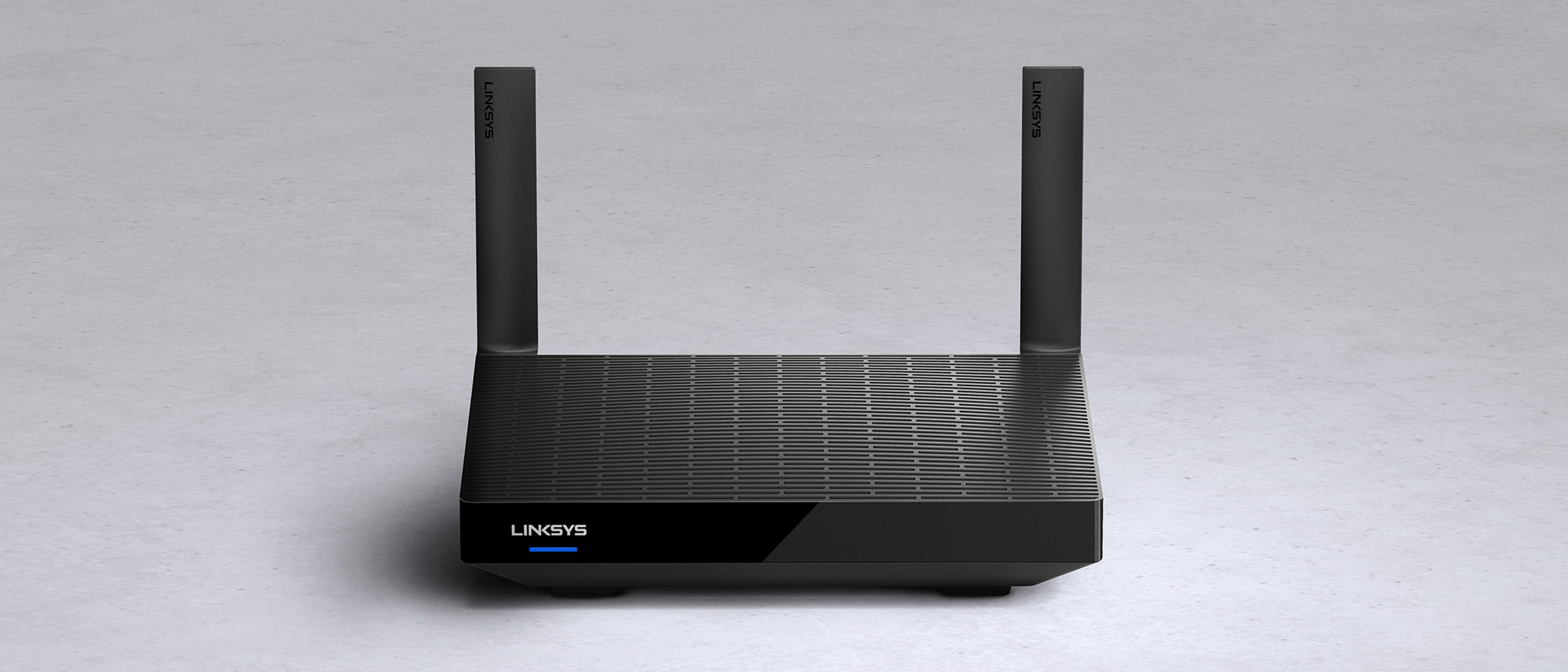Tom's Guide Verdict
The Linksys MR7350 brings the features and performance potential of Wi-Fi 6 at the price of an AC router, but it comes up short in terms of throughput, security software and customization options. With a super-affordable price, it’s a basic Wi-Fi 6 home router built for the AX era.
Pros
- +
Budget-friendly priced Wi-Fi 6 router
- +
Small size
- +
Low power use
- +
Can set up mesh network
Cons
- -
Lacks security software
- -
Short range
- -
Low performance potential
- -
Limited customization options
Why you can trust Tom's Guide
Wi-Fi Spec: AX1800
Number of Antennas/Removable: 2/No
Ports: 1 WAN/4 LAN gigabit per second, USB 3
Processor/Memory/Storage: quad-core 1.2GHz/128MB/256MB
Wi-Fi chip: MediaTek MT 7915
Peak 802.11ac performance: 478.3Mbps (at 15 feet)
Range: 90-feet
Size: 8.5 x 6.1 x 2.2 inches
Estimated Annual Electricity Cost: $5.70
If you thought that the new features and performance possibilities of the best Wi-Fi 6 routers were out of reach on your budget, think again because the Linksys MR7350 Mesh WiFi 6 router makes it doable for a lot less. As you'll see in our Linksys MR7350 review, this budget-friendly is basic and lacks the high performance options available on other routers but it's a good all-around router for those who aren’t too demanding and are replacing an antiquated 802.11N router. It may not be able to keep up with high-end Wi-Fi 6 routers in terms of performance and defensive software, but it can save on power bills.
Reliable and able to fulfill its basic goals, the MR7350 has few frills. Those looking for higher performance should wait for the next round of Wi-Fi 6 routers. Still, it does a lot with a little and delivers 802.11AX technology for the masses.
Linksys MR7350 review: Design
Small and easy to hide, the 8.5 x 6.1 x 2.2 inch Linksys MR7350 can blend into the background, regardless of whether it’s on a desk or a bookshelf. It was designed to sit horizontally but can stand vertically, although its status LED gets covered. The router has convenient recessed inserts underneath for mounting it on a wall.
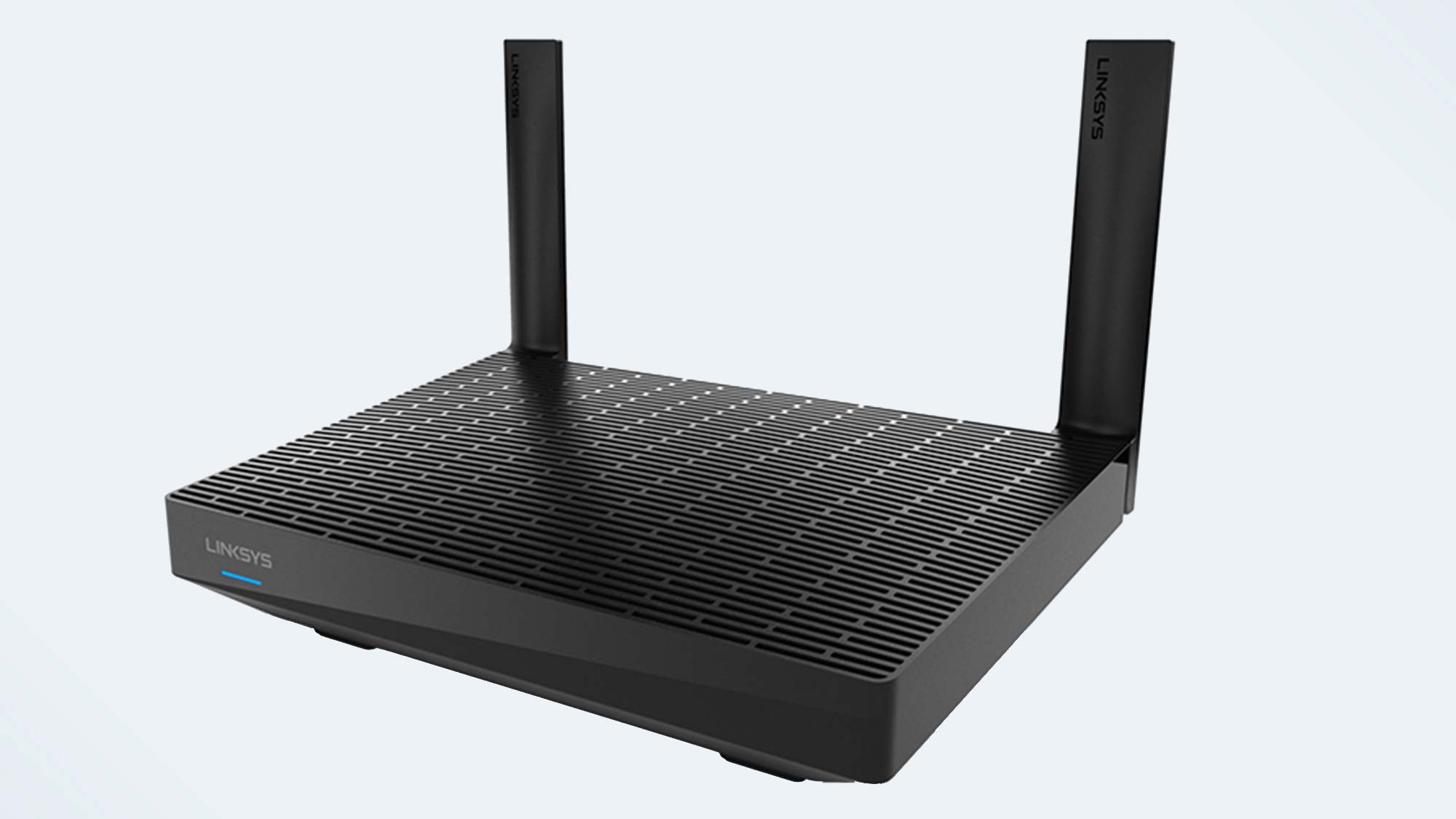
The MR7350’s black plastic case has cooling vents on top and bottom and never got above 97 degrees Fahrenheit during heavy-duty testing. In addition to an internal patch antenna, the MR7350 has a pair of external antennas in the back that are a welcome sight compared to routers that sport six or eight antennas. They add 4-inches to its height when extended and can be rotated 180-degrees and angled to grab the strongest signal. The antennas, however, can’t be replaced.
A dual-band design, the MR7350 creates 802.11AX networks that move data over 2.4- and 5GHz portals. According to Linksys, the MR7350 can easily service up to 25 devices, which might be overkill for many families but it should future-proof the router for the next few years. Overall, the router can move up to a theoretical 574Mbps in 2.4GHz mode as well as 1.2Gbps in 5GHz mode. It adds up to an AX1800 throughput rating.
Powered by a Qualcomm IPQ6000 Wi-Fi chipset, the MR7350 has a 1.2GHz quad-core processor and 512MB of RAM. Its 256MB of storage holds the system’s settings and firmware.
It has beamforming technology to customize the transmissions to the receiver and MU-MIMO technology to satisfy a large number of connected clients at once, but it falls short of the mark when it comes to high-performance options that we’re starting to take for granted in the Wi-Fi 6 era, like the use of 160MHz data channels.
Get instant access to breaking news, the hottest reviews, great deals and helpful tips.
On its own, the MR7350 can cover up to 1,700 square feet, but it has a trick up its digital sleeve. The router can work with other recent Linksys products to create a mesh network from scratch. Called Intelligent Mesh, the router can connect to the Linksys MR8300, the Linksys MR9600 and the Linksys Velop mesh system to fill a large home.

The back of the router has a basic connection panel. In addition to an input networking port for your modem, the MR7350 has four output Ethernet ports. All can handle gigabit per second data streams, but the MR7350 lacks the ability to use a Multi-Gig input or aggregate two ports for higher downstream throughput. There’s a USB connector for adding an external hard drive to the network, as well as a power switch and Wi-Fi Protected Setup (WPS) button for quickly and securely connecting a device. The router’s recessed reset switch returns the system’s software to its factory settings.
This is the router to get if you hate blinking colored lights flashing day and night, because the MR7350 has a single LED bar to show its status and nothing more. When the light is blue, the router is online and working properly, although it turns yellow when its connectivity is poor and red when it’s offline and needs attention.
The MR7350 comes up short by doing without extra security software. Many of its competitors supply this increasingly popular feature, although some, like Netgear, charge for updates to counter the latest hacks.
Linksys MR7350 review: Performance
After using the Linksys MR7350 for more than a week, it proved to be a reliable router for general household Internet access, although its output sometimes varied. It was just as good at streaming 4K videos as checking on email, but lacks the performance-oriented options that other more expensive routers provide. On the other hand, based on testing with Ixia’s ixChariot’s network simulation benchmark in my 100-year old 3,500-square-foot home, the MR7350 won’t let you down.
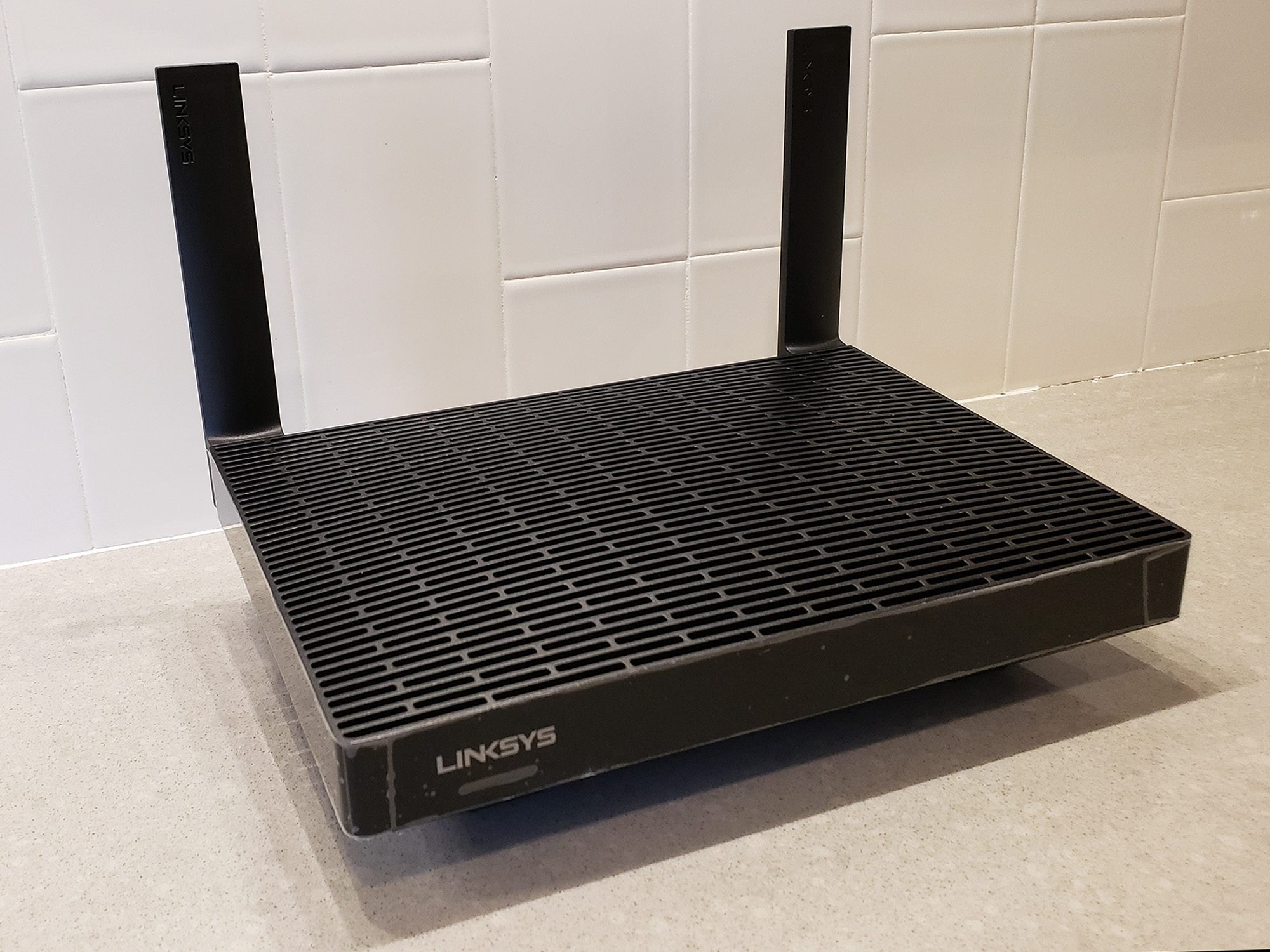
With the device and router separated by 15-feet, the MR7350 moved 478.3Mbps, 23 percent less throughput than the similarly affordable TP-Link Archer A7 (623.5 Mbps) mustered. It’s important to note that the Archer A7 is a mainstream 802.11AC (Wi-Fi 5) system while the MR7350 is an 802.11AX (Wi-Fi 6) device. It just goes to show that when it comes to budget-priced routers, opting for the newer standard may not give you the best performance every time.
Even compared to other Wi-Fi 6 models, the Linksys MR7350's throughput lagged behind the latest high-performance AX routers, like the Asus RT-86U (at 929.7Mbps), the TP-Link Archer AX6000 (884.4Mbps) and the Netgear Nighthawk XR1000 (at 859.1Mbps).
The gap between the MR7350 and the rest of the router world increased at 50-feet, with the MR7350 delivering 167.2Mbps, or about half of the 396.7Mbps that the TP-Link Archer AX6000 was capable of moving. By contrast, the Asus RT-AX86U, and Netgear Nighthawk RAX80 were able to move 285.3Mbps and 271.3Mbps.
At 75-feet, the MR7350 only mustered 15.3Mbps of data delivery, just enough to support a 4K video stream but nothing else. At the same distance, the Asus RT-AX86U moved 250.1Mbps and the Netgear RAX80 moved 142.1Mbps – roughly 10-times as much data.
The 4.0Mbps of throughput I recorded at 90-feet was just enough for getting email and watching an HD video. At the same distance, the TP-Link AX6000 was offline, while the Netgear RAX80 led the way with 20.8Mbps with the Asus RT-AX86U at 7.4Mbps. The MR7350 had a range of 90-feet, 10-feet farther than the Archer A7’s 80-feet, but it left several areas uncovered in my home.
It was adequate at pushing data through walls and floors, with the MR7350 moving 408.8Mbps through a wall 25-feet from the router and 312.3Mbps up a floor into a bedroom directly above the router. That’s well off the pace set by the AX6000, which handled the same tasks at 744.7Mbps and 671.4Mbps.
When it came to supporting the data needs of several devices, the MR7350 did well by feeding enough data to play videos on my HP EliteBook Dragonfly, while playing an Internet radio station on a Samsung Galaxy S7+ tablet as I watched a baseball game on my iPad Pro and a Dell XPS 15 was moving data onto and off a file server. The video and sound came through without a problem.
By using just 5 watts of power, the MR7350 ends up being one of the most economical routers on the market. All told, if it’s running 24/7, it should cost about $5.70 a year in electricity bills if you pay the national average of 13 cents per kilowatt hour. That’s roughly half as much as routers like the TP-Link Archer AX6000’s $11.30 per year.
Linksys MR7350 review: Setup
The MR7350 router can be installed using a simple Web interface or the Linksys app. There’re versions for iOS (iPhones and iPads) as well as Android tablets and phones.
After making sure the router’s LED status bar was blinking purple, showing it was ready to be configured, I plugged in the router’s power adapter and connected it to my broadband modem using the included Ethernet cable. Once it completed its Internet check, I needed to create an account with Linksys.
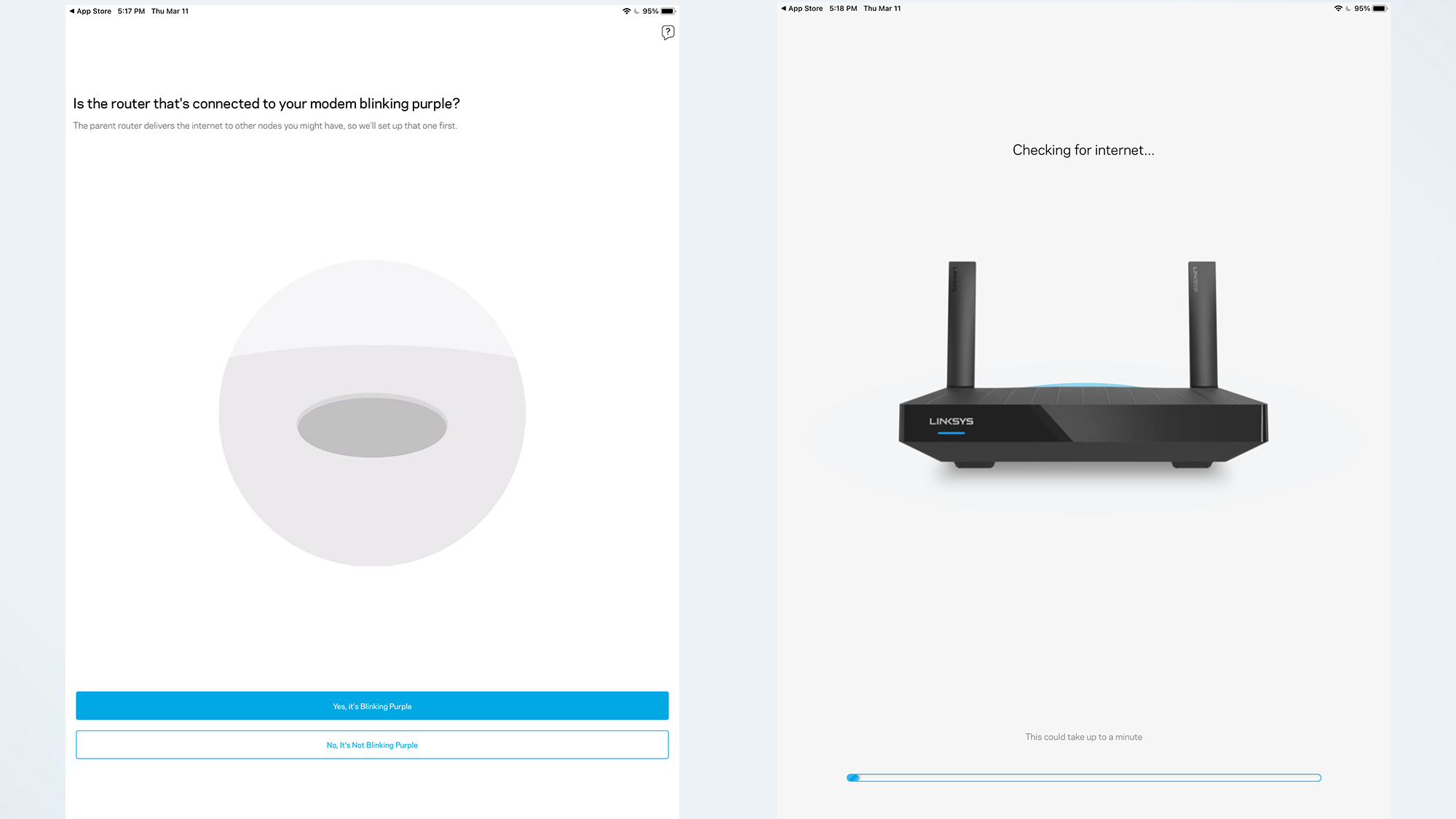
The router then links itself to the account and automatically configures the hardware. Next, it asked what room the device was going to live in. On the downside, the router couldn’t give the 2.4- and 5GHz networks different names.
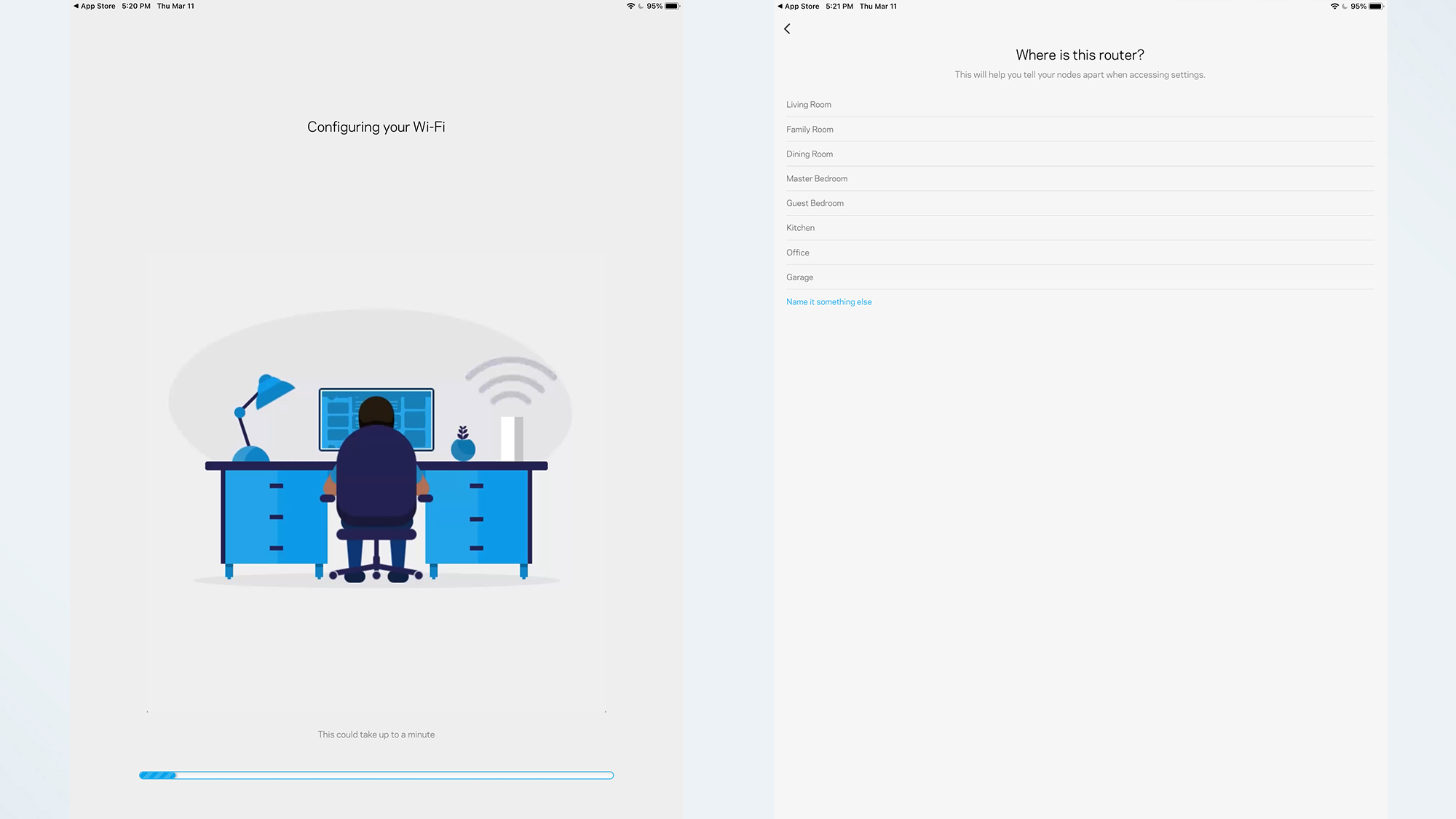
Not quite done, the MR7350 finished with a firmware update but doesn’t present a printable summary page of the settings. It took 8 minutes and 30 seconds to get the MR7350 online.
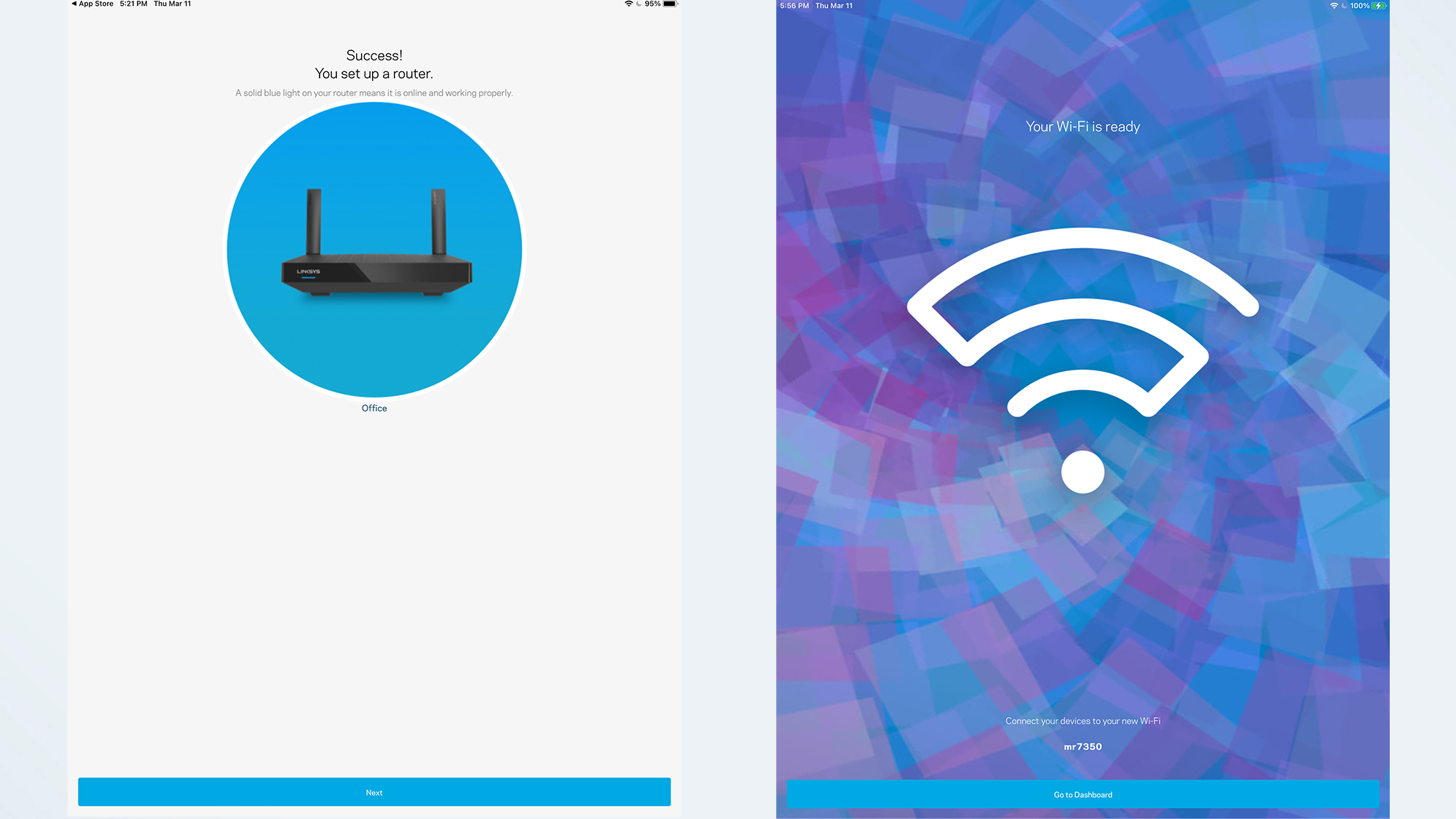
Linksys MR7350 review: Configuration
As easy as it was to set up the MR7350, it didn’t offer a lot of customization and options through the app; you can use the browser approach if you like by typing “linksyssmartwifi.com" into the address bar. The app’s main page shows that the router’s online and allows you to configure the guest network or test its current connection speed.
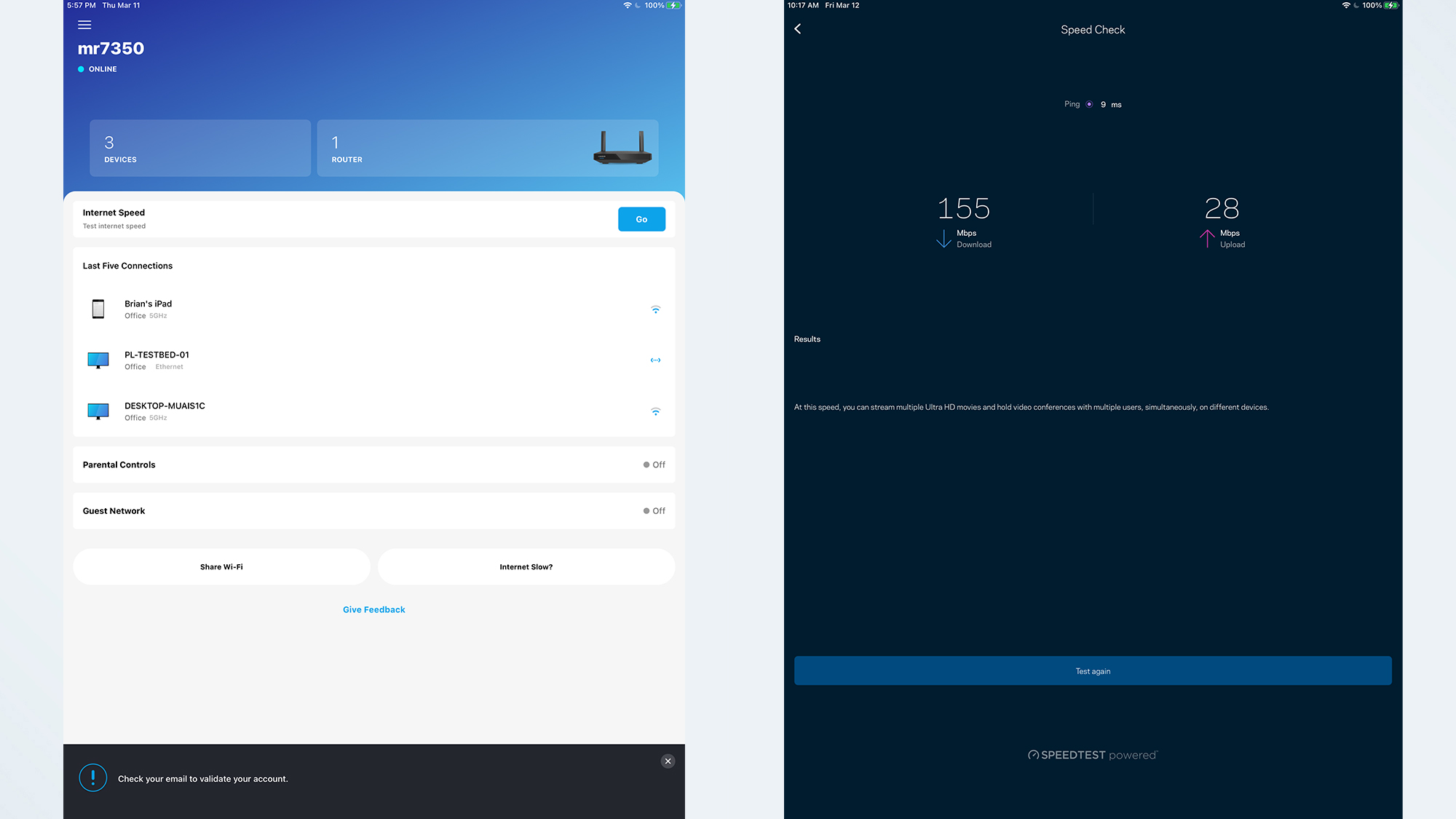
Those who are new to Wi-Fi will appreciate the Share Wi-Fi link at the bottom to text, email or copy the network name and password to send to a trusted companion. Next to it is troubleshooting help for those with slow Internet.

Dig a level deeper and the Linksys app offers a list of operational items that ranges from the Wi-Fi Settings to Network Administration. The router can prioritize who gets the lion’s share of the data and setting it up is as easy as picking a device (presumably mine) from a list.
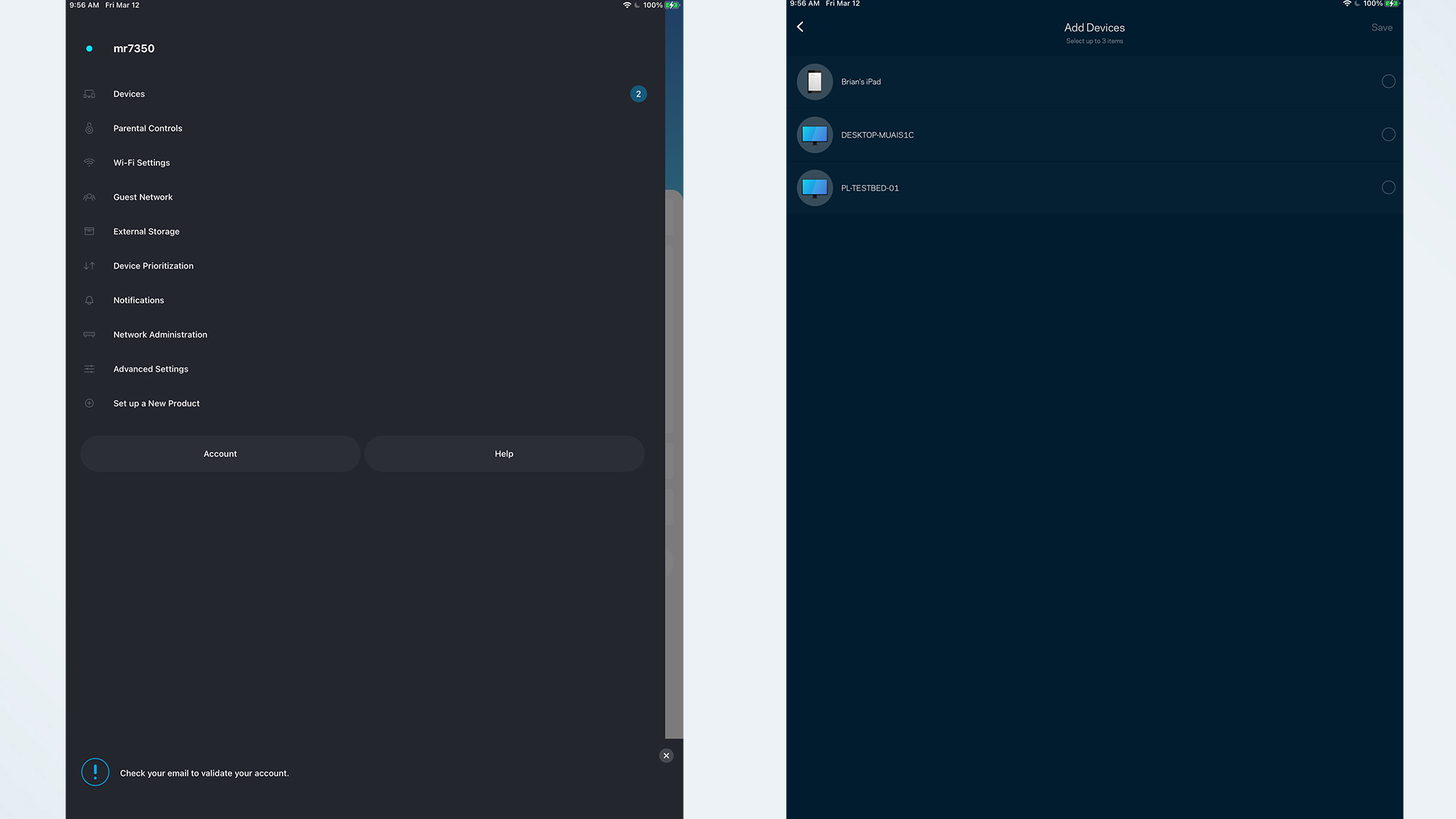
In addition to changing the IP address and DNS servers, the MR7350 lets you scan the local Wi-Fi environment to avoid crowded channels. It took about a minute to check out my area and confirmed that I was using the best channels.

The MR7350's 1-year warranty is standard for the industry, although it is better than Netgear’s 90-day limit on service. The Linksys site has lots of DIY material to help set up and optimize the router. In addition to help using the app, there’s a downloadable manual as well as assistance with installation, logging in and adding devices.

Linksys MR7350 review: Verdict
The Linksys 7350 takes a step forward for 802.11AX buyers on a budget. At $120, it brings the new Wi-Fi 6 technology within reach of most of those looking to replace an older, slower and less secure router. It’s small, very economical to use and can be part of a Linksys-based mesh network to fill a large home with Wi-Fi data. On the downside, the MR7350 does without things we’re starting to take for granted in routers, like extra security software to keep a network and its devices malware-free and performance enhancements like wide data channels and the ability to aggregate ports.
In the final analysis, the MR7350’s ability to move data from here to there is its biggest disappointment, with it underperforming compared to the TP-Link Archer A7, an older Wi-Fi 5 router (and still a favorite budget model among the best routers). The best bet might be to wait and get a second-generation mainstream Wi-Fi 6 router, but if you crave the latest Wi-Fi technology and can’t afford models that cost several hundred dollars, the value-conscious Linksys Max-Stream MR7350 does the trick.
Brian Nadel is a freelance writer and editor who specializes in technology reporting and reviewing. He works out of the suburban New York City area and has covered topics from nuclear power plants and Wi-Fi routers to cars and tablets. The former editor-in-chief of Mobile Computing and Communications, Nadel is the recipient of the TransPacific Writing Award.
